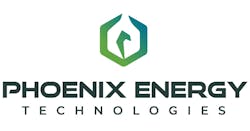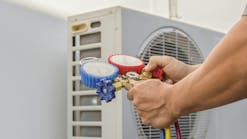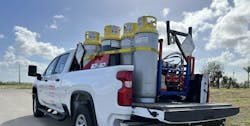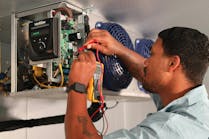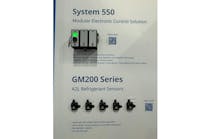Realizing the Potential for Predictive Maintenance in Commercial Refrigeration
It seems that everywhere you turn today, companies are touting the vast potential of the Industrial Internet of Things (IIoT). Ideally, the IIoT can provide enhanced fault detection and more accurate predictive maintenance. It’s assumed that more data — in type, variety and frequency — is the basis for higher value via new, algorithm-driven software. Whether the value is realized by adding intelligence at the device level with building management systems (BMS) or at the enterprise level using building intelligence platforms is less important than the domain experience needed to interpret this expanding richness of information. Data scientists will need to understand the context of the extracted information in order to maximize its value, so the secret to this will be to keenly leverage new technology with real-world human experience and know-how.
The IIoT features new technologies that will likely result in less-expensive devices which will be more widely deployed and interconnected. But creating value from real-time data is not new. For example, real-time vibration analysis of rotating machinery has been utilized in the industrial automation industry for decades. In the multi-site retail segment, HVAC systems — predominantly rooftop units (RTUs) — have been fully characterized and modeled, and today many efficiency optimization and predictive failure offerings are commercially available. Benefits of these offerings can include: significant energy savings, lower maintenance and service costs, and improved customer experiences and comfort.
Delivering on the promised value of IIoT of combinging more data with next-generation analytics will require fundamentally changing the way we approach commercial refrigeration.
Considering the proven historical value of IIoT and its accelerating adoption, the question remains: “When will we begin to see new data- and algorithm-driven applications in the commercial refrigeration sector?” Answering this question requires an understanding of the inherent complexities and diversity of commercial refrigeration applications.
Commercial refrigeration systems consist of many interdependent components — often originating from multiple vendors — designed to meet a wide variety of applications, ranging from coffin-style display cases to walk-in freezers. Industry macro trends further increase this complexity, including the adoption of new refrigerants and the migration from centralized to distributed (stand-alone) systems.
Deriving value from these complex, multi-vendor systems — often comprised of widely varying data types and availability — makes the tasks of data modeling and algorithm definition more difficult. And, when you factor in other external factors such as weather, humidity and climate variances — not to mention widely varying operator goals, processes and workflows — you can start to comprehend the depth of the challenge predictive maintenance presents in commercial refrigeration.
Delivering on the promised value of IIoT — combining more data with next-generation analytics —requires more than simply installing connected sensors and devices and then creating libraries of algorithms. It will mean fundamentally changing the way we approach commercial refrigeration that includes the ability to combine new technologies with deep domain experience within the “context” of widely varying system requirements.
In the meantime, the industry must avoid the rush to IIoT implementation that would simply result in creating applications which compound the problem by creating more “noise” — i.e., a barrage of events to monitor and triage — and triggering false errors or events that identify issues too early (or too late).
Understand, extract and interpret: fostering innovation through clear problem definition
At Emerson’s innovation centers and in customer field trials, we’re tackling this challenge head on. By modeling refrigeration applications, we’re taking a methodical, deliberate approach to predictive maintenance. Our goal is not to simply throw more IIoT at the problem (although that’s definitely part of the solution); it’s more about inferring true insights from the data while leveraging our deep intellectual capital in the commercial refrigeration space to help deliver the transformative value that predictive maintenance represents. By doing so, we’re simplifying the complex and uncovering insights that are representative of the industry’s most common refrigeration scenarios.
A successful implementation of a predictive maintenance solution starts with a clear understanding of the problem at hand. This requires significant expertise of the commercial refrigeration domain as well as familiarity with its implementation nuances across the retail enterprise. Without this expertise, there’s a tendency to come up with a solution for a problem that doesn’t exist, or merely focus on the data without understanding the domain or what it represents.
In addition to understanding the problem and having access to the right data, another key ingredient is understanding how the data is generated and, of course, the ability to interpret it properly.
Once the problem is well understood, the next challenge is ensuring that the data needed to explore the problem is readily available. Between our innovation center efforts and customer field trials, Emerson utilizes the necessary sensors to provide a wealth of data. This data can then be effectively leveraged to help develop solutions that address the needs defined by our in-house domain experts.
In addition to understanding the problem and having access to the right data, another key ingredient is understanding how the data is generated and, of course, the ability to interpret it properly. In most cases, this data comes from sensors that are utilized for control, monitoring and analysis. That’s why having inherent knowledge of the characteristics of the sensors, as well as how sensor output is converted to “data” by a control and monitoring system, are critical to ensuring proper interpretation of the data.
At Emerson, deriving predictive maintenance solutions from machine-learning technologies is a three-pronged approach. It includes: 1) possessing deep knowledge of the domain; 2) extracting the required data; and 3) understanding how application sensors are utilized and converted to usable data. Only then can we take the next crucial step to effective interpretation for true predictive maintenance.
John Wallace is director of innovation for Emerson.


